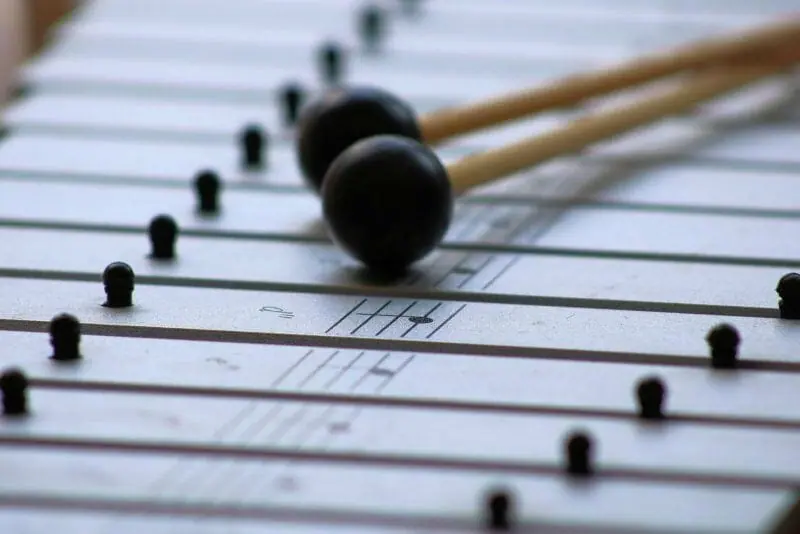Looking to jumpstart your songwriting? Being intentional about the intervals you use can turn a good song into a hit.
Today you’ll learn everything you need to make purposeful decisions about intervals.
What Are Intervals?
In music, the term interval has its own special meaning. An interval describes the difference in pitch between any two notes.
Intervals tell you exactly how much higher or lower one note is compared to another. It’s used for when the notes are played separately or at the same time.
In songwriting, intervals appear in both the melody you write and the harmony you use.
They help create beautiful and distinctive melodies. Sometimes you can recognize a song from just two notes and the interval between them!
Even if you write tunes intuitively, getting to grips with intervals will make you a better songwriter. Let me explain.

To get from one note to another in a melody, you can go up (ascend), down (descend), or stay where you are.
Some intervals will deliver completely different effects to your audience.
Intervals and Their Labels
Interval names depend on two things. Interval quality and interval quantity, how far apart the two notes actually are.
Interval quantity is a number figured out by counting notes. Either as lines and spaces on the music stave or letters in a scale.
You include the first or root note as 1 and read left to right.
So the interval quantity between C and D is a second:
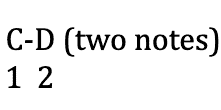
While the interval quantity between C and A is a sixth:

Here it is on the stave.

The interval quantity where the notes are the same is called unison.
You can have simple intervals of a second, third, fourth, fifth, sixth, and seventh. Or the eighth, which is often called the octave.

The quality of the interval is figured out by the number of semitones or half steps between the two notes. It is given as a prefix.
Perfect intervals include unison and octave but also perfect fourths and perfect fifths.
Why perfect? These intervals can live in either major or minor keys.
If you flip or invert them, they’re still perfect, and their harmonic quality is considered consonant. They sound good.
Perfect intervals get the prefix P, so a perfect fourth is P4.

Major is used for the second, third, sixth and seventh, and the prefix is a capital M.
Minor intervals are a semitone or half step smaller and use a lowercase m prefix.
So the interval of a minor third is called m3, while a major seventh is called M7.
Two other types of interval prefixes are augmented and diminished.
If a major or perfect interval is one half step larger, it’s called augmented. You can use the symbols Aug, A, or + for short.
Diminished intervals are minor or perfect intervals that are one half step smaller. They use the prefix dim, d, or the symbol ° .
Here are all the simple intervals on the stave.

A special term you might come across is the tritone, which is an augmented fourth (A4) or a diminished fifth (d5). Same interval, different names!
Intervals and Instruments
No matter what instrument or what key, all the intervals remain the same.
An octave (P8) is an octave on a guitar, a MIDI editor, your piano, or your voice.
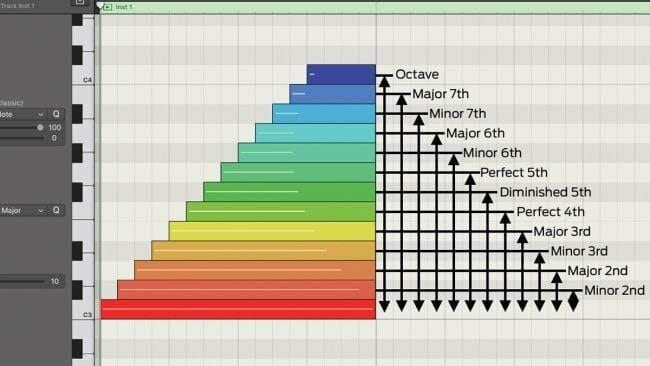
A major seventh (M7) is a major seventh, whether it’s in the key of C major (C to B) or A major (A to G♯).

It’s about the relationship in pitch between two notes: the first or root note (R) and the second note. Or if you play them at the same time, the lower note to the higher note.
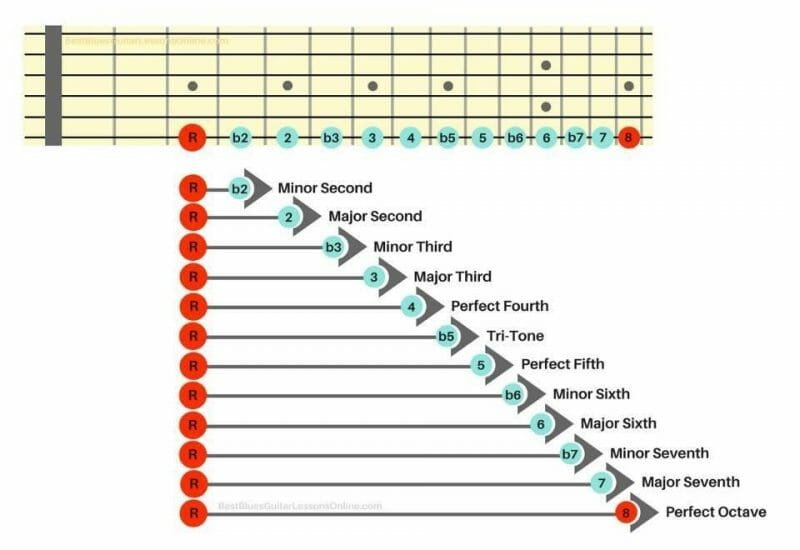
Intervals in Songs
OK so that’s intervals and their labels, but let’s get back to how they sound and what they can do in a song.
Time for a swim…
When I was a kid, my parents wouldn’t let me go and see Jaws because of the nightmares (mine) they would have to endure. So I read the book (still got nightmares), but worse, I listened to the music (got daymares and nightmares).
That’s the power of a minor second interval (m2).
Only a half step or a semitone apart between E and F. But the effect is ominous, dissonant, and ultimately terror inducing.
Even 45 years later, the theme is immediately recognizable!
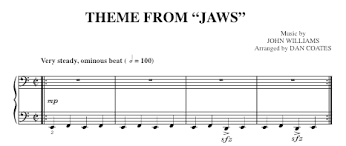
Contrast the major second (M2) that you can hear in the first line of “Happy Birthday.” Way less threatening!
The major third (M3) also appears in the opening line of the ABC song used to teach the alphabet. And the minor third (m3) can be heard in the beautiful and gentle classical piece by Brahms called “Lullaby.”
Using either of these intervals in the melody will quickly establish whether your song is in a major or minor key.
They also tend to make the mood of the music very clear. Happier in the major, and sad or wistful in a minor key.
Using the perfect fourth (P4) creates more space. Maybe even a sense of ambiguity because of its lack of tension.
“Here Comes the Bride” uses an ascending P4 to great effect. The theme song from Born Free has a descending perfect fourth right on the opening lyric.
The perfect fifth (P5) is considered extremely stable. It features heavily in the basic triads that make up the bulk of a song’s chord progression.
Used together with the root note, it creates power chords and is common in both Celtic and metal music.
Used in the melody, it can sound spacious or kind of free and is often used for uplift. You can sure hear that here in the first two notes of Star Wars.
The tritone sits between the perfect fourth and fifth and creates what I call a WTF feeling.
A great example is the theme music for The Simpsons. Enjoy Green Day’s version!
Here’s an interval cheat sheet of reference:

Once you start getting into the higher intervals, the songs are more “melodic.” The distance from the first to the second notes is much larger.
When you use these, they’re referred to as leaps, while the smaller intervals move as steps or skips. Using them can have a big impact on your song’s melody.
Most songs don’t have many big leaps. Usually, one large interval will be followed by several steps and skips.
That way, the song is still singable. Too many leaps makes songs harder to follow.
An example of this is in Michael Jackson’s “Man in the Mirror.”
The chorus uses a descending major sixth (M6) just once on the first two syllables.
I’m start-ing with the man in the mirror
![]()
You can see right after the big downward leap, the rest of the melody climbs pretty much stepwise back up.
The same happens in the example used for an ascending octave (P8) in “Somewhere Over the Rainbow.”
The chorus uses an octave leap on the two syllables “some-where.” This is immediately followed by much smaller steps and one skip on the rest of the phrase “over the rainbow.”

The leaps with the larger intervals are matched with big lyrical messages too. Of hope and yearning from “Somewhere Over the Rainbow” to West Side Story’s minor seven (m7) underscoring “There’s a place for us.”
Then there’s the curious case of the major seventh (M7). It’s used in famously few songs. It sounds great in chords, but not so much in melodies.
Since it’s so close to the more stable and comfortably pitched octave (P8), writer’s usually opt for the octave. So if you want to make a name for yourself, write a song with an interval of a major seventh in it!
The final chart identifies which intervals have more consonance or dissonance.
The idea is not to avoid dissonant or clashy-sounding intervals. Use them to highlight tension and release within your songs.
In fact, overusing so-called consonant intervals, especially the smaller ones, can make a song sound juvenile at best or cheesy at worst.
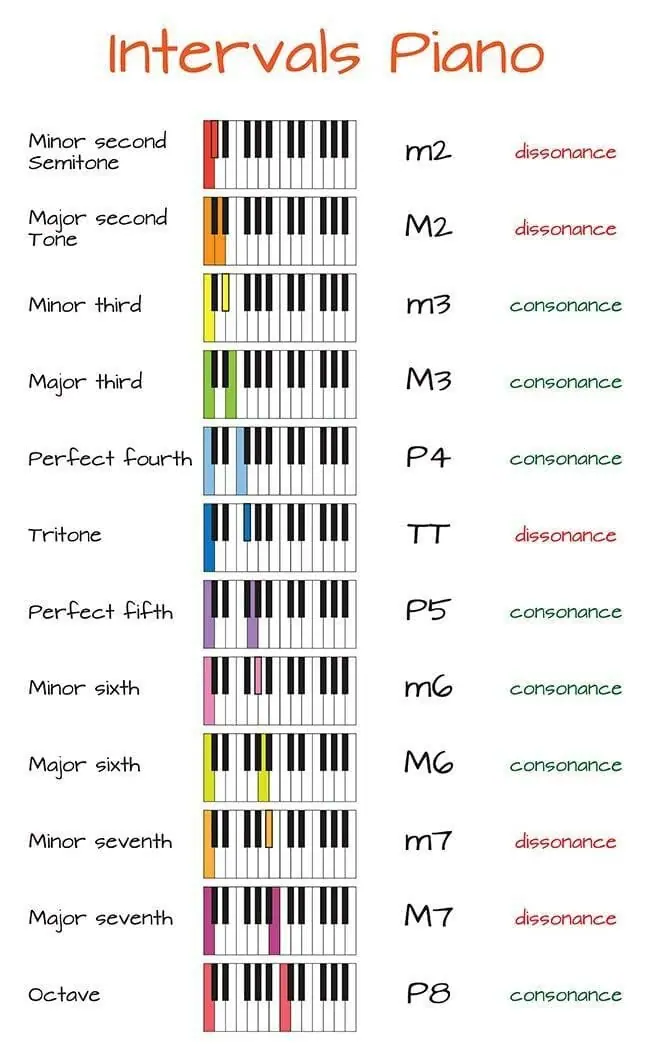
There’s definitely a place for all the intervals. One that’s well matched with a prominent lyric can seriously stamp a signature on a song.
Most contemporary songs have a melodic range of an octave plus two notes.
So wrap your head, or really your ears, round the intervals between unison (P1) and an octave (P8). It’s a great place to start.
Conclusion
Intervals are a crucial part of writing effective melodies and harmonies. Being deliberate about which intervals you use can really up the ante in your songs.

